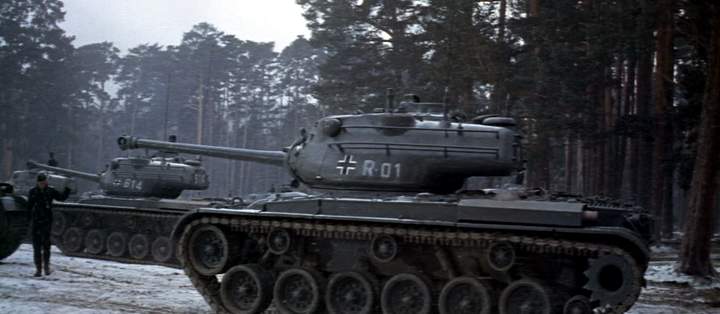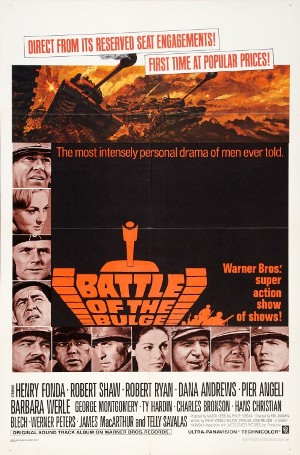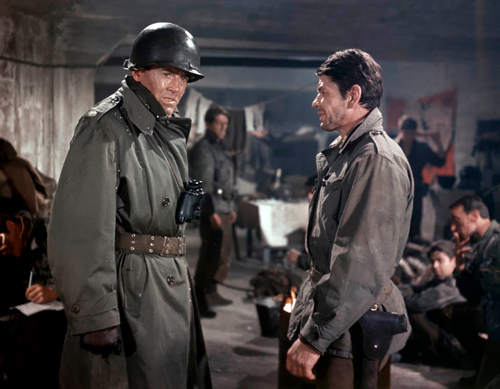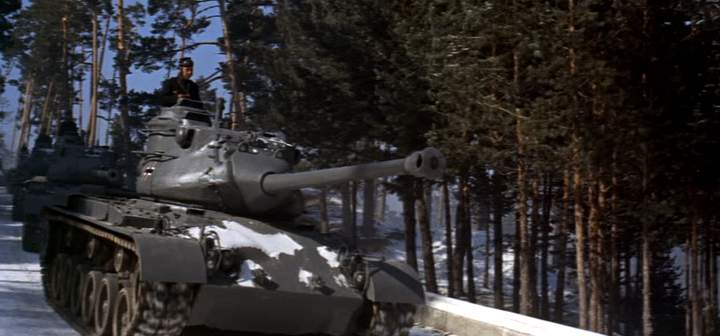‘Battle of the Bulge’ is an American classic war movie, it was made in Spain and hit the screens in 1965. It was directed by Ken Annakin. The starring cast included Charles Bronson, Telly Savalas, Henry Fonda, Robert Shaw, Dana Andrews, and Robert Ryan. The world premiere of the movie was in Hollywood, CA, at the Pacific Cinerama Dome Theatre.
The premiere, on December 16, 1965, was the 21st anniversary of the Battle of the Bulge.
The producers tried to condense a month long battle into three hours. The battle extended across sections of Germany, Belgium, and Luxembourg. Some of the landmarks that were used for the film did not even resemble locations where the actual battle took place.
This left the filmmakers open to criticism for historical inaccuracies, even though they maintained that they had “re-arranged” the sequential order of events in the movie credits to amplify the remarkable story for the moviegoers.
Most World War II sagas contain depictions of real senior Allied leaders, civilian or military, but unlike those movies, the ‘Battle of the Bulge’ contains virtually none. Apparently, this is because of the disagreements about the battle itself during and after the war.
During the battle, a German counteroffensive caused many Allied casualties, as the Allies were completely surprised by the strength of the assault; though in the end, the battle was won by the Allied forces.
The Plot
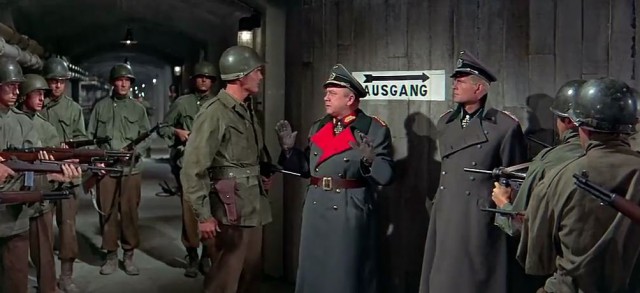
Former policeman and now Military Intelligence Officer, Lt. Col. Daniel Kiley (Henry Fonda) and his pilot, Joe, are flying over the Ardennes forest on a reconnaissance mission, as they spot a German staff car.
In an underground lair, German Col. Martin Hessler (Robert Shaw), an imaginary German soldier presumed to be based on SS – Standartenführer Jochen Peiper and General Kohler (Werner Peters) are talking about the allocated time for an attack on the Allies.
Gen. Kohler shows him a clock that is counting down from 50 hours. Hessler is told that if victory is not in their hands by this time, the Nazi troops will run out of supplies and have to pull back.
On another front, Nazi troops disguised as American soldiers, commanded by Lt. Schumacher (Ty Hardin), are tasked with capturing strategic bridges and causing chaos behind enemy lines.
In the meantime, Kiley is at headquarters, where he alerts Allied Command that the Nazis are preparing to launch another all-out offensive. Kiley’s commanders, Gen. Grey (Robert Ryan) and Col. Pritchard (Dana Andrews), dismiss the warning.
All of the available intelligence indicates that the Germans don’t have the manpower or the resources to launch another full-scale attack.
In an effort to gain additional proof, Lt. Col. Kiley visits a US infantry stronghold on a captured portion of the Siegfried Line under the command of Maj. Wolenski (Charles Bronson). Some very inexperienced and young Nazi soldiers were captured during a patrol led by Sgt. Duquesne (George Montgomery) and Lt. Weaver (James MacArthur).
Kiley draws the conclusion that the experienced German troops have been replaced by these young soldiers, while the experienced Nazi troops had been gathered for the offensive that Kiley was certain about, but Pritchard dismisses this as well.
The next day, Hessler begins the offensive. Awakened by the noise of German tanks, Wolenski and his infantrymen head into the wooded area of the Schnee Eifel, where an intense fire-fight ensues; they try to fight them off but the German assault is too strong and Woleski and his men are overrun.
A company of American tanks, commanded by Sgt. Guffy (Telly Savalas) is attempting to slow the Panzer Division, but Guffy’s tanks’ inadequate guns and thin armor make their defensive effort futile, forcing the American tanks to retreat.
Lt. Schumacher and his patrol, disguised as American military police, capture the only bridge capable of supporting heavy tanks over the Our River. Hessler maintains his spearhead moving toward Ambleve, all the while being monitored by Kiley.
Lt. Schumacher and his men take control of a crucial junction connecting the Siegfried Line, Malmedy, and Ambleve. He changes the road signs, and Wolenski’s troops, in fast retreat, take the wrong road to Malmedy; nearly the entire unit is massacred. Only Lt. Weaver is successful in escaping, but Duquesne is slain.
The US troops become suspicious when they observe Schumacher’s “military police” incorrectly placing munitions on the Our bridge, and his deception is exposed.
Hessler’s Panzer Division and the Nazi infantry attack Ambleve and the town finally falls into German hands. Kiley, Grey, Pritchard, and others find an escape route to the River Meuse, although many Americans, including Wolenski, are captured.
American forces regroup and begin plans for a counterattack. During a dangerously foggy night, Col. Kiley conducts an aerial scouting mission in an effort to find the main German front. In an attempt to listen for the German tanks, he instructs the pilot to shut off the engine and glide over the enemy area.
Unexpectedly, through an opening in the fog, he sees Hessler’s tank column advancing on American lines. Kiley radios the coordinates, but his plane is shot down by German artillery and Kiley crashes near an American fuel depot.
In the meantime, Gen. Grey’s forces, with the Meuse River at their back, prepare to counter-attack Hessler. The heavier guns and stronger armor of the Panzer tanks methodically destroyed the American tanks, but at a great expense to the Germans, as they consumed much of their fuel.
Most of the surviving American tanks and their crews, including Guffy and Weaver, headed to the fuel depot.
Aware of his tanks’ fuel shortages, Hessler decided to take a detachment to the fuel depot to capture its inventory. Guffy, Weaver, and the American stragglers arrive first. Upon arrival at the fuel depot Weaver instantly recognizes Lt. Schumacher, who is still impersonating an American MP and his men have seized command of the fuel depot, but Schumacher doesn’t recognize Weaver.
At Weaver’s order, the masquerading Nazis are fired upon and are all killed. The US defenders saturate the road with gasoline and set it afire.
The German tanks, including Hessler’s, are nearly all demolished by the fire.
The remaining German forces concede defeat and retreat all the way to Germany.
Historical inaccuracies
The tank battle mentioned above is a vague representation of the Battle of Celles fought on December 26, 1944, where the German 2nd Panzer Division was defeated by the U.S. 2nd Armored Division.
The movie creates the untrue impression that great numbers of American tanks were destroyed by the heavy Tiger IIs and in the process decoyed the enemy off course so they would run out of gas. Truth be told, the Panzers were already stranded.
Even the tanks used in the film are not historically accurate (despite the claims of the producer in an interview).
The tank used in most of the scenes was the M24 Chaffee light tank. Although they were World War II era tanks, they were not in use in the numbers that were seen in the movie.
The American M47 Patton in the film that represented the German Tiger tanks, however, expressed the superior size and firepower which the M4 Sherman tanks had to contend with, depicted by the aforementioned M24 Chaffees.
Apart from the early American confrontations with the German assault, there is also the absence of the actual weather conditions in which the real battle was fought, such as cold weather and snow; there is no trace of snow at all in the major tank battle scene.
Other inaccuracies were that some battle scenes that were fought in the flat and bare territory; taking into consideration the mountainous, forested, and grassy environment of the Ardennes.
The film was actually shot on location in Madrid, Spain and the Sierra de Guadarrama mountain range of the Iberian peninsula.
The movie sequences with Lt. Schumacher and his men were based on Operation Greif, the Nazi plan to parachute English-speaking Germans using American equipment behind American lines to capture bridges and to spread confusion in the enemy lines.
Absent from this film is the attack by Gen. George Patton’s troops, whose Third Army alleviated the siege of Bastogne. Although British troops had a smaller part in the battle than the Americans, in the movie there is absolutely no reference to British forces in the area.
Also not mentioned is Gen. Eisenhower ceding temporary command of two American armies to British Field Marshal Montgomery in the northern half of the Bulge. This decision was made to split the Bulge into two fronts; the film implies a completely American offensive.
The movie also made no mention of the role the Allied air power had as they hit the Germans forces hard when the weather cleared.
The film’s narrator, William Conrad, does mention both Montgomery and Patton in the beginning, but is incorrect, saying: “In the south was Patton’s Third Army. To the north, stood Montgomery’s Eighth Army.”
In fact, to the north, Montgomery’s command was actually the 21st Army Group. Montgomery’s previous command, the Eighth Army, was actually in Italy during the Battle of the Bulge.
Correctly, though, Patton was in charge of the Third Army during the battle, it was one of four American armies that constituted the 12th Army Group under Gen. Omar Bradley. Patton’s Third Army in the south was only part of a much larger American force.
The film does realistically capture some major aspects of the battle, representing how inexperienced American replacement troops positioned in the Ardennes were initially overpowered and how confused the situation was.
It refers to the dominance of the German heavy tanks, along with their primary weakness; a lack of fuel.
Some early scenes, which showed briefings among German officers, accurately portray the Third Reich’s desperate need to cut the U.S. – British supply lines and to nullify the Allies’ huge logistical superiority.
Production
During the film production, the Spanish Army supplied approximately 500 fully equipped soldiers and 75 tanks and armored vehicles, some of World War II vintage, for little cost and with no restrictions.
Reaction
Although former President Eisenhower was retired, he denounced the film at a press conference for what he considered such a gross historical inaccuracy.
In 1966, the film was one of the most popular movies at the British box office.
